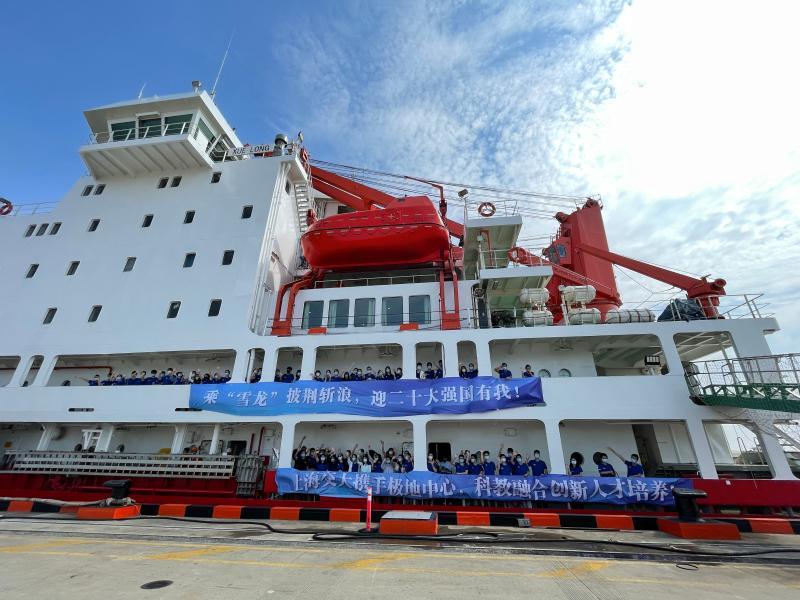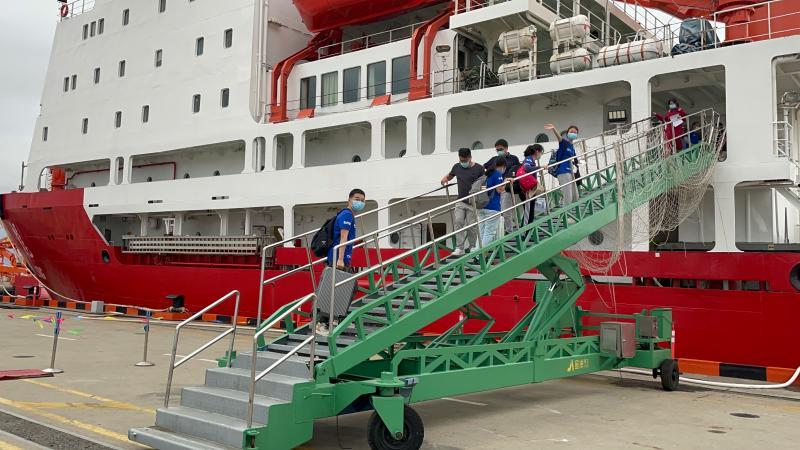On August 31st, over 80 teachers and students from the School of Oceanography of Shanghai Jiao Tong University (SJTU) boarded the icebreaker Xuelong. During the trial voyage from September 1st to 6th, they worked with professionals from the Polar Research Institute of China under the Ministry of Natural Resources to deliver a weeklong project, “Practice on the Sea”, combining science with education. On the same day, the ceremony for the trial voyage and the project kick-off was held at the institute. On the morning of September 1st, the icebreaker set sail, and the SJTU teachers and students were on board in the Yellow Sea, learning the basic knowledge of marine investigation and maritime safety emergency response, and operating in groups with advanced facilities for maritime scientific research.

The project, “Practice on the Sea”, is the first and only compulsory course in universities across Shanghai presented by the SJTU School of Oceanography in 2018. As the first platform for scientific and educational integration jointly recognized by the Ministry of Education and the Ministry of Natural Resources, the SJTU School of Oceanography launched the course on Xuelong for the first time this year.

As China’s largest polar icebreaker, Xuelong has traveled across five oceans, setting many records in the history of Chinese navigation. This project will cover six major fields of study in marine research: physics, chemistry, biology, geology, technology, and strategy. Zhou Meng, Dean of the SJTU School of Oceanography, served as the voyage’s chief scientist. More than 80 teachers and students from the school and over ten professionals from the institute were involved.

Before boarding the icebreaker, a two-day online theory course was organized, which included the instruction of various academic disciplines and maritime safety, with a subsequent online theory test. “This is my first voyage at sea, and I was worried about getting seasick. But the maritime safety education and theory course in the past two days taught me how to prevent and treat seasickness. The teachers also gave us a detailed introduction to deck safety, which was both comprehensive and practical,” said Duan Yonghu, a student from the SJTU School of Oceanography who looked forward to the upcoming practice at sea after participating in the online instruction.
On the afternoon of August 31st, after the ceremony, Liu Shunlin, Director of the institute, delivered the first lecture entitled “Monitoring China’s South and North Poles: Progress and Outlook”. He introduced what the institute had done at the poles, such as the research on ice and snow and climate change based on polar glaciers, the life process and environment based on polar microorganisms, and Antarctic astronomy and space science based on polar atmosphere and environment. Then, the teachers and students boarded the icebreaker and settled down for the next day’s departure. “Xuelong is so cool!” exclaimed Wang Yanlin, a student from the SJTU School of Oceanography, who had always yearned for the sea ever since she was a child but had never thought she would become a member of the crew on the icebreaker so soon.
After boarding the icebreaker, the teachers and students carried out a series of emergency response exercises, such as the ship abandonment exercise and the fire drill. They were also educated on operations safety again to get a stronger sense of maritime safety. During the maritime internship from September 1st to 6th, under the guidance of the SJTU teachers and the professionals from the institute, the students carried out the marine navigation observation in groups. They conducted a range of operations, including the midship CTD, the vertical trawl of plankton, and the stern box and multi-tube sediment sampling. In addition to the operations, this course was accompanied by a workshop on polar scientific research and activities to allow students to understand China’s marine scientific research and build patriotism.

“As one of the first platforms for scientific and educational integration jointly recognized by the Ministry of Education and the Ministry of Natural Resources, we have been exploring a new model of scientific and educational integration in talent development. This year, we put the classroom on Xuelong. Based on the efforts to ensure the scientificity, rationality, and feasibility of practical instruction, we have worked with the institute in developing the plan for implementing the instruction, in the hope of integrating theory with practice to develop young talents specializing in maritime research across science and technology,” said Zhong Yisen, Associate Professor of the SJTU School of Oceanology, who was in charge of the instruction. He said that the school attached great importance to the practice of maritime scientific research in the process of talent development. The teachers taught the students at sea and allowed them to participate in international marine scientific research across China’s Bohai Sea and Yellow Sea, as well as the East China Sea, South China Sea, Pacific Ocean, Atlantic Ocean, and Arctic Ocean.
In April 2021, the SJTU School of Oceanology was recognized by the Ministry of Education and the Ministry of Natural Resources as one of the first platforms for scientific and educational integration. With the strong support of the Ministry of Natural Resources, it was the first time that the icebreaker Xuelong was used to carry out maritime activities for SJTU students, a brand-new attempt at scientific and educational integration.


